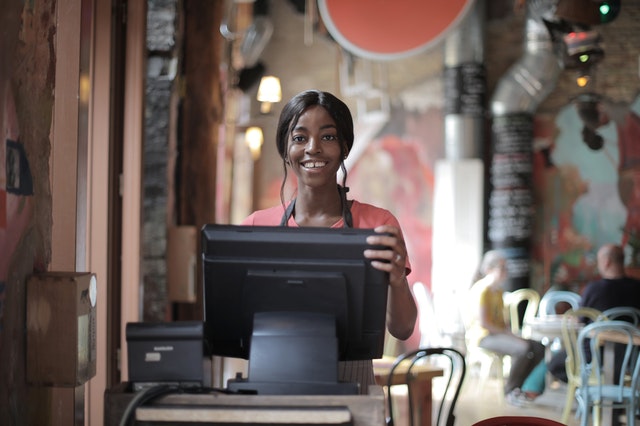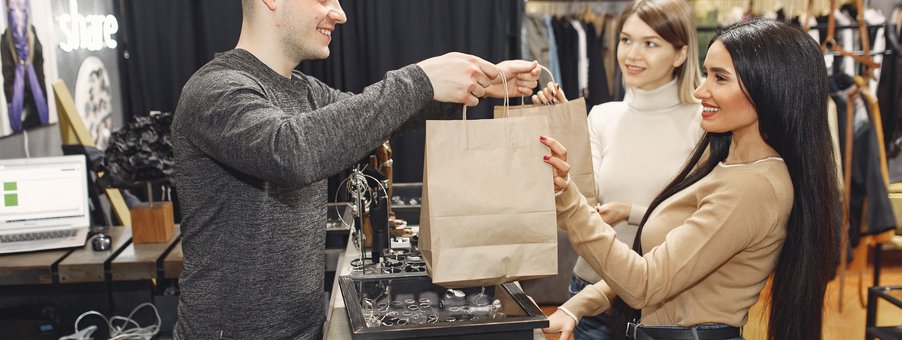Many retail stores offer similar products, with the majority being available to research, compare and buy online. If the customer has a particular product in mind, competition for that customer’s purchase will be tough, as you will be up against every other online retailer as well as brick-and-mortar shops. A reliance on constant discounts and special offers is a sure-fire way to low margins, unprofitability and potentially insolvency.
So, how can you beat the competition and increase your sales?
Two words: customer experience. It’s vital to make the product secondary to a memorable customer experience. The products purchased by your customers should be souvenirs of an incredible shopping experience, one that they will not be able to forget, and which they will be clamouring to repeat.
Creating such an experience is simple. Start with the following steps:
Happy Employees
Employees make up the frontline of a retail operation. If they’re unhappy or uninformed, customers will notice immediately. The consequences of poor customer service can have a major detrimental effect on your reputation. Whereas 87% of customers tell others about a good shopping experience, 95% share their bad experiences. Negative word of mouth spreads like a forest fire and can have damaging repercussions for a retail brand.
Those employees who are informed, educated, and well-trained have greater confidence and job satisfaction, which will be clear to customers. For example, John Lewis and Waitrose, whose employees are renowned for providing an exemplary, personalised customer service. M&S is another company that has a reputation for having well-mannered staff that are efficient at resolving issues when they arise, and Waterstones’ employees are often hailed for being friendly and knowledgeable.

Employees who are skilled in the art of sales are an asset to brick-and-mortar retailers. When consumers are looking to buy a high value item or a considered purchase, such as the latest games console or a new laptop, how can physical retailers hope to win on price alone, when all a customer has to do is pull out their smartphone on the shop floor and add an item to their virtual basket for a cheaper price? In this instance the shopping journey is really important, and retailers have to go above and beyond to create a positive and memorable experience. The customer is king, and they want to be made to feel like one.
On the other hand, if a customer is in the market for something functional, such as a set of screwdrivers or a paintbrush, the price is likely to be the determining factor, any special offers or discounts will sweeten the deal.
The fact remains that in many instances’ retailers can’t always win on price alone. The winning strategy has to be based on providing an exceptional customer experience. Customers want to buy due to emotion, and when emotion is encouraged in a sale, it is far more powerful than price. It is the employee’s job to appeal to a customer’s emotions; to make them to feel something, and get them to say, “I love it! I need to buy it right now!”
Make Customers Feel Safe in Your Store
In this age of Covid-19, one of the best things a retailer can do to attract people into their stores and drive sales is to instil confidence in customers. Due to the pandemic, many people are worried about their health and safety. This is why footfall has fallen dramatically since the re-opening of stores, and why e-commerce has expanded rapidly during 2020.
Retailers must communicate what measures they are taking to ensure the safety of their customers if they have any hope of persuading them back into stores. They should broadcast their message via multiple channels including their advertising, website, email marketing, social media, and even via notifications on mobile apps. For the store itself, it is imperative that employees implement the safety measures; they are ambassadors for their brand and must take full responsibility for protecting themselves, their colleagues, and members of the public.
Appeal to Children
If children are having a good time in a retail store, then it’s likely that the parents will have a positive experience as well, potentially leading to an increase in sales. Also, if the staff are friendly and welcoming to children, it will give customers a great feeling about the brand.
You don’t have to own a children’s store to benefit from creating an in-store experience that appeals to the little ones. For many parents, shopping of any sort provides a much-needed excuse to leave the house and to interact with the wider world. For retailers, there is a huge opportunity to make their store a destination for parents by providing an interactive shopping experience that keeps the kids engaged.
Retailers could introduce bold colour schemes and create funky floor graphics that can be used to engage young customers and draw their attention to products that appeal to their age group. Combining graphics with a point-of-purchase display near the checkout will increase a brand’s impact and maximise excitement, bringing products to life in a way that will appear to smaller shoppers. For example, at Easter time in some Tesco stores, you can find an amazing yellow brick road graphic telling the children, “Easter treats this way!”
Another way to inject excitement for children is to create a play area for children to hang out - such as the Playzone at Trago Mills, or the indoor parks that can sometimes be found at retail outlets such as McArthurGlen. Another great way to appeal to children is to use recognisable visuals of characters they love. For example, Sainsbury’s have recently brought back Lego cards, with bright, fun POS everywhere in-store, and an offer that rewards children with one pack of cards for every ten pounds spent.

The Need for Speed
There are specific attributes for in-store layouts that have proven successful, such as speed, cleanliness, and product selection. In today’s fast-paced society, where customers expect immediate assistance and instant gratification, the last thing retailers should do is make their customers wait.
Once a customer knows what they want, retailers should help to funnel them through the path-to-purchase as quickly and easily as possible. This type of seamless transition is offered everywhere online and is increasingly expected elsewhere. Brick-and-mortar stores have one obvious advantage over online shopping: immediacy; they should do everything in their power to capitalise on it. A great example of how a retail brand is making the shopping journey quicker and easier for their customers is Asda, who have introduced a virtual queuing system. It allows users to book a spot in a virtual queue using their smartphone, then they wait in their car and are alerted when they are allowed to enter the store. It encourages customers to visit the store instead of losing them to an online rival, and the customer is treated to the best of both worlds: they have the knowledge, provided by real-time data, of when a store is busy and therefore when the best time is to shop, and they benefit from the immediacy of proper shopping in a physical store.

Music, Ambience, & Culture
Music selection and sound design in a retail store can completely transform a shopping experience. Much in the same way that a soundtrack can elevate a film to echelons of greatness, music can do the same thing for a physical store. Sometimes people pay too much attention to visual stimuli, but tend to forget that sound plays a crucial role as well. By choosing an engaging soundtrack for your store, it will create a certain mood and develop a unique culture to make your brand stand out.
Experience Matters
There are many strategies that can be utilised by retail stores to enhance the shopping experience for their customers and consequently increase sales. The five tips listed in this article form the foundation of making a brick-and-mortar store truly great so that they can rival the likes of local competition and the e-commerce juggernauts.
RMS is a leading provider of retail support services, offering a wealth of experience in how retailers can enhance the in-store customer experience.
